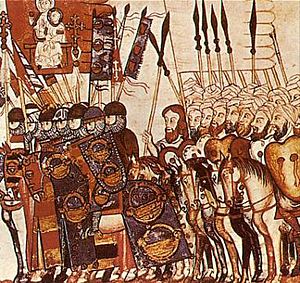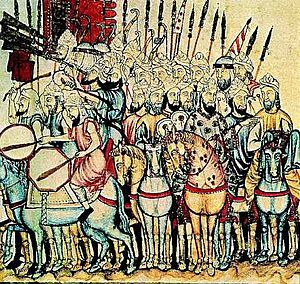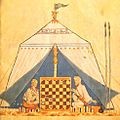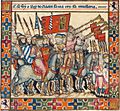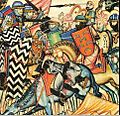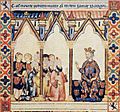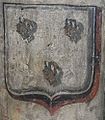Moors facts for kids
The Moors were Muslim people who lived in parts of Spain, Portugal, and North Africa during the Middle Ages. In Europe, the word "Moor" often refers to people whose families came from North Africa.
The Moors, who were mostly from the Berber people of North Africa, came to what is now Spain and Portugal. They had a very big impact on the culture of these countries. They captured a region and named it Al Andalus, which means "land of the vandals."
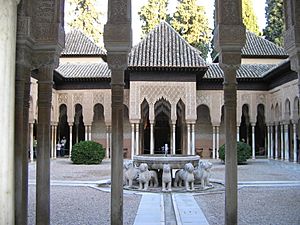
What Does "Moor" Mean?
The name "Moor" comes from an old Berber tribe called the Mauri. Their kingdom was called Mauretania. This area is now part of Morocco and western Algeria. The Romans used the name Mauri for all the native people of North Africa who were still ruled by their own chiefs.
The Moorish Empire in Spain
In the year 711, some Moors, who were a mix of Arabs and Berbers, invaded Spain. Spain was then ruled by Christian Visigoths. Their leader was Tariq ibn Ziyad. They landed at Gibraltar and quickly took control of most of the Iberian Peninsula (Spain and Portugal) in just eight years.
The Moors tried to move into Europe across the Pyrenees Mountains. But they were stopped by the Christian Frankish leader Charles Martel at the Battle of Tours in 732. The Moors then ruled in Spain and Portugal for several centuries. Only small areas in the northwest and the Basque Country stayed Christian.
After some time, the Moorish state in Spain faced internal problems. It broke into many smaller Islamic kingdoms. These kingdoms were later united under the Caliphate of Cordoba. Meanwhile, Christian states in the north and west of Spain slowly grew stronger. Places like Galicia, León, Navarre, Aragon, Catalonia, Portugal, and Castile became Christian again over the next few centuries.
In 1212, Christian kings, led by Alfonso VIII of Castile, pushed the Muslims out of Central Spain. However, the Moorish Kingdom of Granada continued to thrive for 300 more years. This kingdom is famous for amazing buildings like the Alhambra palace.
On January 2, 1492, Boabdil, the last Muslim ruler in Granada, gave up his kingdom to the armies of a newly united Christian Spain. The remaining Muslims were forced to leave Spain or become Christians. These descendants of Muslims were called moriscos. Many of them were farmers in areas like Aragon, Valencia, and Andalusia. They were forced to leave Spain between 1609 and 1614. About 300,000 people had to leave their homes.
Most of the expelled Moors went to Morocco, Algeria, and Tunisia. They helped develop the culture in these countries. Some also became pirates. A number of them in Andalusia joined the Gypsies who were arriving at that time. This mix of cultures helped create [Flamenco] music.
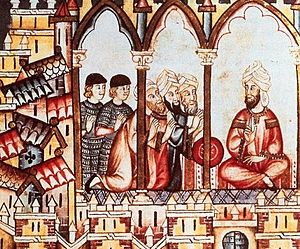
Moors Today
Today, the words Moor or Moorish are used to describe people from West Africa whose main language is the Hassaniya dialect of Arabic. These Moors mostly live in Western Sahara and the Islamic Republic of Mauritania. Mauritania even got its name from them! There are also many Hassaniya-speaking communities in Mali and Senegal.
The Moors today are divided into two main groups: White Moors and Black Moors. White Moors are nomads of Arab and Berber background with lighter skin. Black Moors are generally thought to be descendants of people who were once enslaved by White Moors. They have adopted the customs and language of the White Moors. Today, slavery is officially against the law. Most Black Moors live independently, though some reports say they still face challenges.
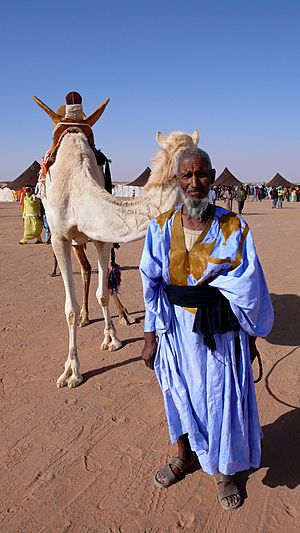
Images for kids
-
A Christian and a Moor playing chess, from The Book of Games by Alfonso X, around 1285.
-
A statue of a Moor being trampled by a conquistador's horse at the Museo Nacional del Virreinato in Tepotzotlán.
-
A performance during the Moros y Cristianos (Moors and Christians) festival in Oliva, Spain.
-
The Great Mosque of Kairouan was built in 670 by the Arab general Uqba ibn Nafi. It was a place of worship for new Muslims.
-
A large painting on the ceiling of the Hall of Kings in the Alhambra palace. It might show the first ten sultans of the Nasrid family.
-
The Moorish army (on the right) of Almanzor during the Battle of San Esteban de Gormaz in the Reconquista, from Cantigas de Alfonso X el Sabio.
-
The Moors asking for permission from James I of Aragon.
-
Muslim musicians at the court of the Norman King Roger II of Sicily.
-
Inside the Mosque–Cathedral of Córdoba.
-
The coat of arms of William II Canynges, a rich merchant. It shows the heads of three Moors.
-
Averroes, a Moorish scholar who was important in philosophy and thinking in Western Europe. Painted in the 14th century.
-
Leo Africanus, who was born in Granada.
See also
 In Spanish: Moro para niños
In Spanish: Moro para niños


